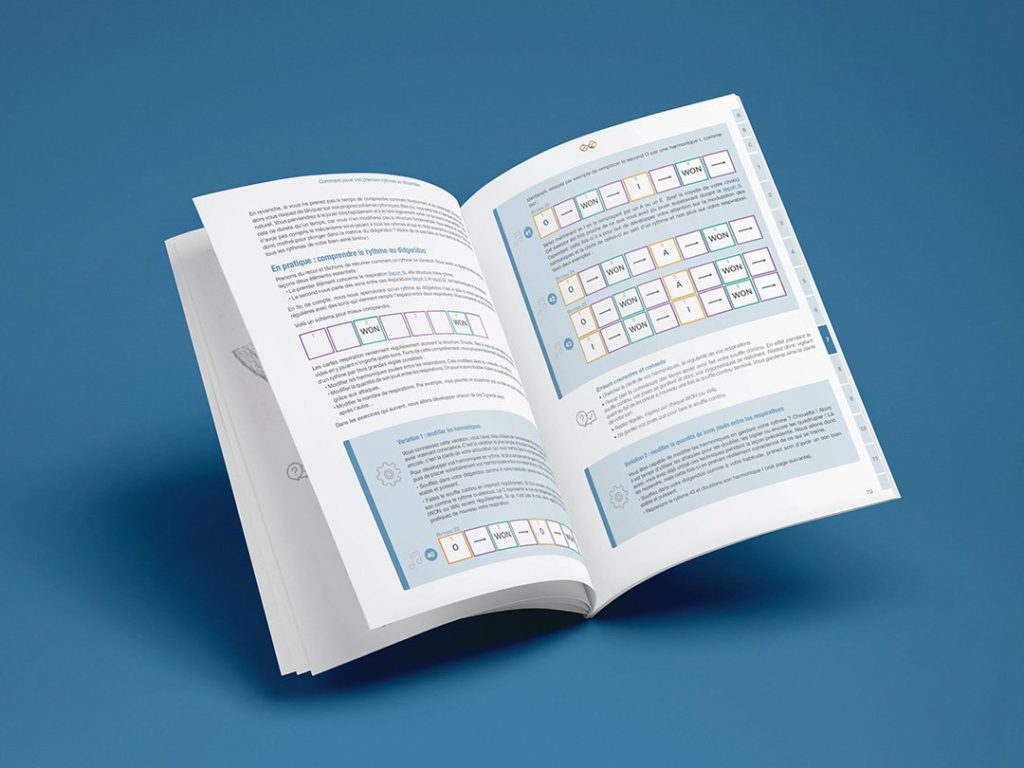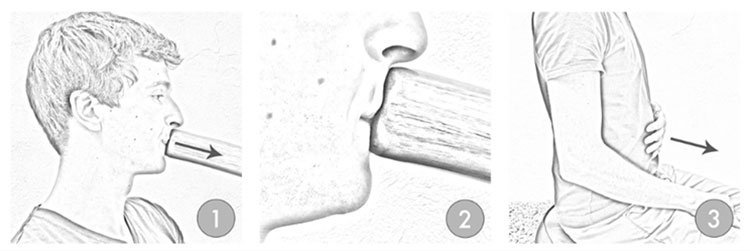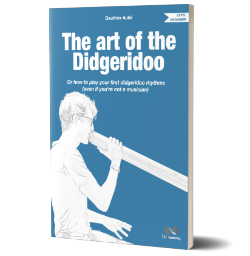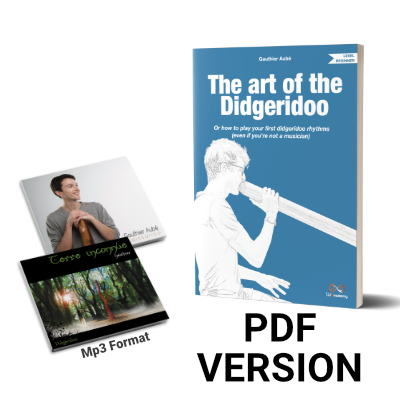The art of didgeridoo
ALL THE BASICS TO START WELL!
This is the ebook version of the video course “The art of the didgeridoo“
The Circular Breathing Within Your Reach
The 4 essential pillars
No Need to Be a Musician
All My Advice Gathered
Who is this didgeridoo method for?
✅ The complete beginner (someone who is eager but doesn't know where to start!)
✅ The self-taught player who has been playing intuitively for years
✅ People suffering from sleep apnea
✅ Readers of my first method released in 2011
✅ Didgeridoo teachers
A few words about my experience
I have been playing the didgeridoo since late 2001. I have met thousands of players, asked myself many questions, and played over and over again.
Driven by passion, I made rapid progress. I then gained recognition in the French and European didgeridoo community. In 2008, playing the didgeridoo became my profession. Since then, I have been conducting workshops and classes in France and Europe.
In 2017, six years after writing my first didgeridoo method, it was time to rewrite everything (I kept only about 10% of the first method, if even that!). I have enriched this work with 10 years of research.
It would be my pleasure if my work could help you progress in playing the didgeridoo!
What you'll find in this method
PART 1 | Essential basics
This section, comprising three chapters, will introduce you to the origins of the instrument and the essential practical points. An introduction to the subject that will give you all the information you need to get off to a good start!
Chapter 1 - Introduction to the Didgeridoo
Chapter 2 - How to Choose Your Didgeridoo
Chapter 3 - Essential Theoretical Foundations

PART 2 | It's Your Turn to Play!
Here, you will dive into hands-on practice through a precise and structured methodology. I have gathered the essential techniques for progressing in didgeridoo playing. There are 11 lessons to explore according to your level and interests:
Lesson 1 | How to Play Your First Sound
Lesson 2 | Refining Your Drone with Harmonics
Lesson 3 | Circular Breathing or How to Play without Ever Stopping!
Lesson 4 | Lighten Your Breathing with Your Belly!
Lesson 5 | Develop Your Intuitive Playing
Lesson 6 | Attacks: Adding Rhythm to Your Phrases!
Lesson 7 | Play Your First Rhythms!
Lesson 8 | Discover Percussion with Overtones
Lesson 9 | Drop-jaw: The Slow Motion Effect
Lesson 10 | How to Sing into Your Didgeridoo
Lesson 11 | Reach New Heights and Compose Your Own Rhythms

Diagrams to illustrate

Let's play the didgeridoo together!
Exercise – The importance of pressure
Exercise – High vocalizations

Wakatoo sets the rhythm for you
Rhythm 7

Already familiar with music theory?

What readers say
"Just a quick message to say thank you, because this is much more than a method you're offering us... It's a bible! To self-discovery. "

"I started Gauthier's new method by trying to start from scratch, taking everything from the ground up. The evolution is very progressive, precise and detailed. The "tips and errors" are a good way of refocusing, and the drawings clarify positions. Comparing this method with others I've already read, this one is clearer and infinitely more precise and complete."

"I'd like to congratulate you on this excellent work, which really brings together all the essentials (and more) about learning to play the didgeridoo.
Personally, I've been playing the didge for 17 years. Your book made me aware of techniques I had already mastered but didn't understand!
I also wanted to buy your book to help me play with my band and be able to write a score adapted to the didge. The aim is for my compadres to be able to understand and even write themselves when they need a specific rhythm.
Great idea to have created Wakatoo, at least now we have a language specific to our instrument."

"Gauthier's new method is fantastic. Since I've had it, I've made a quantum leap. I'd been stagnating and going round in circles for months, and didn't know what to do to get over the hurdle.
His advice freed me up. There's still a lot to discover, but it gives me great satisfaction to have been able to take this step and get back on the road."

"Gauthier's method is very methodical and fun to read. I really enjoy it, so much so that I do exercises every day! You can also refer to the sounds recorded in MP3 to fully understand the exercises and the expected result. The help on choosing a didgeridoo is most welcome. This is a very complete guide for beginners. Methodical, after a month I'm up to lesson 5... But first things first. It's a real pleasure to learn and discover the exercises step by step.

"Just a quick note to congratulate you and thank you for your method, which is brilliant. I am progressing little by little, I am delighted with the advice and the CD."

"Thank you for this gold mine! I worked through the first lesson this weekend and have already received all the answers to the questions I had! Thank you so much, really. I look forward to progressing with you and your brilliant pedagogy."

"I received your method! I haven't read everything yet because I'm trying to take it a step at a time. I read your exercises, I practice...
I think you've done an excellent job, efficient and easy to understand. The fact that you've added your own anecdotes brings it to life, so we don't end up reading a banal book on "how to play the didgeridoo in 10 steps". You give us a real method with exercises you've practiced yourself, as well as your feelings on some of them, in short, it's very enriching! We can also feel your passion, which is great ;). Voila... A short message for a big thank you. "

"Gauthier's method is brilliant. The harmonics, the drone, the position of the body, etc. etc. It's really top notch. I've made progress in just a few days! I started from scratch and already have a good feeling with the continuous breath. It's motivating! The audio tracks are a real plus, allowing you to compare your results and make adjustments. I've read the first four chapters and that's more than enough for now. With this alone, I've got enough to work on for several months!

"I started practicing the didgeridoo on my own, and since I got your first step learning manual, I'm progressing very fast, especially at the continuous breath level, a lot of important details that had escaped me, anyway this is just to say thank you."

"I already had the first one and everything I understood in it has been refined. You go into more detail. Ultimately, what we need to remember is to play with full awareness, to get into the details of everything.
I really appreciate the use of musical notes to transcribe rhythm. I now know how I need to play to get a rhythm and adjust with a metronome. Thank you for making me realize that I need to work a lot on my breathing to play with greater ease. Thanks again and keep up the good work.

"Incomparable pedagogy, comprehensive, innovative, playful and full of wisdom; I recommend this book to all didgeridoo practitioners.
I am immensely grateful for this outstanding and generous work."

To summarize!

3 Chapters
introducing you to the world of the didgeridoo

11 Lessons
to cover all the didgeridoo basics

95 audio tracks
to illustrate rhythms and exercises

60 rhythms
to help you develop your creativity

50 exercises
based on simple, fun teaching methods
Order the method now!
EBOOK ALONE
-

-
PDF format
-
Over 110 color pages
-
95 audio tracks
-
11 lessons
-
60 rhythms
EBOOK + 2 ALBUMS
-

-
PDF version
-
Over 110 color pages
-
95 audio tracks
-
11 lessons
-
60 rhythms
-
ALBUMS (MP3)
-
Renaissance (11 tracks)
-
Terre inconnue (11 tracks)


